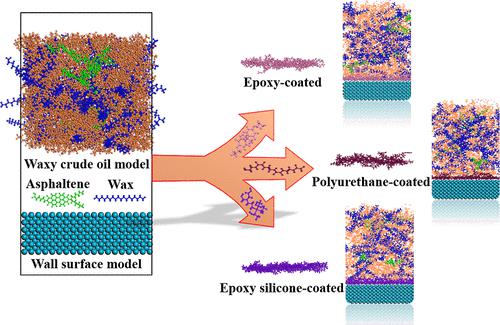当前位置:
X-MOL 学术
›
Energy Fuels
›
论文详情
Our official English website, www.x-mol.net, welcomes your
feedback! (Note: you will need to create a separate account there.)
Effect of a Coated Wall on Wax–Asphaltene Molecule Diffusion, Aggregation, and Adhesion Mechanism: A Molecular Dynamics Simulation Study
Energy & Fuels ( IF 5.2 ) Pub Date : 2022-08-16 , DOI: 10.1021/acs.energyfuels.2c02183
Zhihua Wang 1 , Xiaoyu Liu 1 , Jinling Li 2 , Jiajun Hong 1 , Yaming Qi 1, 3 , Xiaowei Li 4
Energy & Fuels ( IF 5.2 ) Pub Date : 2022-08-16 , DOI: 10.1021/acs.energyfuels.2c02183
Zhihua Wang 1 , Xiaoyu Liu 1 , Jinling Li 2 , Jiajun Hong 1 , Yaming Qi 1, 3 , Xiaowei Li 4
Affiliation

|
Coating is increasingly used as a cost-effective strategy for controlling heavy component deposition in waxy crude oil transportation flowlines. This paper systematically investigated the micro influence mechanism of the coated wall on the diffusion, aggregation, and adhesion behavior of wax–asphaltene molecules by the molecular dynamics (MD) method. A set of experiments was performed to determine the properties of the waxy crude oil. For overcoming the limitations of the model simplification of previous MD studies, the MD models based on experimental data were developed to characterize the motion behavior of wax–asphaltene molecules on non-coated and coated wall surfaces, and the simulated densities of crude oil components had an error of less than 5% with the National Institute of Standards and Technology (NIST) data, which showed that the established model was accurate and reliable. The simulation results showed that two condensate oil layers were formed on the non-coated wall surface, the diffusion and aggregation behavior of wax–asphaltene molecules were enhanced under the low-temperature condition, and there was considerably heavy component molecules adhesion to the non-coated wall surface. The analysis of mean square displacement, radial distribution function, and relative concentration distribution revealed that 288.15 K was the peak wax precipitation, which was consistent with the experimental conclusion. It was also found that the presence of low surface energy coating weakened the diffusion of heavy component molecules. The epoxy silicone-coated had the weakest interaction with wax–asphaltene molecules. Moreover, the fact that the coated wall had a certain inhibitory effect on the aggregation and adhesion of wax–asphaltene molecules in the pipeline was proven, where the epoxy silicone-coated had the strongest inhibitory effect. These investigations present new insights and guidance for controlling heavy component deposition by coating in the pipeline transportation process of waxy crude oil.
中文翻译:

涂层壁对蜡-沥青质分子扩散、聚集和粘附机制的影响:分子动力学模拟研究
涂层越来越多地用作控制含蜡原油输送管线中重质组分沉积的一种经济有效的策略。本文采用分子动力学(MD)方法系统研究了涂层壁对蜡-沥青质分子扩散、聚集和粘附行为的微观影响机制。进行了一组实验以确定含蜡原油的性质。为克服以往 MD 研究模型简化的局限性,开发了基于实验数据的 MD 模型,用于表征蜡-沥青质分子在非涂层和涂层壁面上的运动行为,原油组分的模拟密度具有美国国家标准与技术研究院 (NIST) 数据的误差小于 5%,表明所建立的模型是准确可靠的。模拟结果表明,非涂层壁面形成了两层凝析油层,低温条件下蜡-沥青质分子的扩散和聚集行为增强,且有相当多的重质组分分子粘附在非涂层壁面。涂层墙面。均方位移、径向分布函数和相对浓度分布分析表明,288.15 K是析蜡峰,与实验结论一致。还发现低表面能涂层的存在削弱了重组分分子的扩散。环氧有机硅涂层与蜡-沥青烯分子的相互作用最弱。而且,事实证明,涂层壁对蜡-沥青质分子在管道中的聚集和粘附有一定的抑制作用,其中环氧有机硅涂层的抑制作用最强。这些研究为通过涂层控制含蜡原油管道运输过程中的重质组分沉积提供了新的见解和指导。
更新日期:2022-08-16
中文翻译:

涂层壁对蜡-沥青质分子扩散、聚集和粘附机制的影响:分子动力学模拟研究
涂层越来越多地用作控制含蜡原油输送管线中重质组分沉积的一种经济有效的策略。本文采用分子动力学(MD)方法系统研究了涂层壁对蜡-沥青质分子扩散、聚集和粘附行为的微观影响机制。进行了一组实验以确定含蜡原油的性质。为克服以往 MD 研究模型简化的局限性,开发了基于实验数据的 MD 模型,用于表征蜡-沥青质分子在非涂层和涂层壁面上的运动行为,原油组分的模拟密度具有美国国家标准与技术研究院 (NIST) 数据的误差小于 5%,表明所建立的模型是准确可靠的。模拟结果表明,非涂层壁面形成了两层凝析油层,低温条件下蜡-沥青质分子的扩散和聚集行为增强,且有相当多的重质组分分子粘附在非涂层壁面。涂层墙面。均方位移、径向分布函数和相对浓度分布分析表明,288.15 K是析蜡峰,与实验结论一致。还发现低表面能涂层的存在削弱了重组分分子的扩散。环氧有机硅涂层与蜡-沥青烯分子的相互作用最弱。而且,事实证明,涂层壁对蜡-沥青质分子在管道中的聚集和粘附有一定的抑制作用,其中环氧有机硅涂层的抑制作用最强。这些研究为通过涂层控制含蜡原油管道运输过程中的重质组分沉积提供了新的见解和指导。































 京公网安备 11010802027423号
京公网安备 11010802027423号